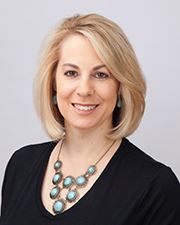 Melissa Greene-Blye is an assistant professor in the William Allen White School of Journalism and Mass Communications at the University of Kansas. She worked for 20 years as an anchor and reporter covering local news in television markets big and small. A former chair of AJHA's Graduate Student Committee, Greene-Blye currently serves as co-chair of the Membership Committee. She has presented research at the AJHA annual conference as well as the Joint Journalism and Communication History Conference.
Melissa Greene-Blye is an assistant professor in the William Allen White School of Journalism and Mass Communications at the University of Kansas. She worked for 20 years as an anchor and reporter covering local news in television markets big and small. A former chair of AJHA's Graduate Student Committee, Greene-Blye currently serves as co-chair of the Membership Committee. She has presented research at the AJHA annual conference as well as the Joint Journalism and Communication History Conference.
When and how did you first become involved in AJHA?
I first became involved with AJHA while still a graduate student at Tennessee. I had taken a historical methods course from Dr. Amber Roessner, and she encouraged me to submit that paper to the 2016 AJHA annual conference. To my surprise and delight, it was accepted and I have been attending and involved in AJHA ever since.
What do you believe is the importance of studying journalistic representations and negotiations of American Indian identity?
A central theme of my work is the importance of connecting the past with the present. Coverage of Native issues, individuals, and identity continues to fall prey to a legacy of misrepresentation established by long ago editors and reporters; if we can understand the historical roots of that misleading representation, we stand a much better chance of improving coverage of Native issues, individuals, and identity in today’s journalism. As for studying negotiations of Native identity, there are two key points: First, is understanding that Native nations and individuals did not always have access to their own press, so we often have to look into the silences in the historical record and be open-minded in using non-traditional sources of information in order to fully understand how Native nations were seeking to be heard and understood by the press of their day. Second, is understanding the purpose of the work Native news outlets were doing in a particular period. This requires a broader research perspective that goes beyond a mere textual analysis of the journalistic content produced by those outlets and which also includes an understanding of tribal culture and politics.
Your professional career was largely in broadcast news. What intersections are there between your professional experience and your historical research agenda?
That is a great question and one I am still coming to understand myself. I often joke that I am like the circus rider who is standing atop two moving horses while simultaneously keeping those horses moving forward together at a steady pace. Two new endeavors are allowing me to use my professional broadcast experience and multimedia teaching experience to educate the next generation of Native journalists: First, I am on the executive team that is launching a Native Media Storytelling Workshop for Indigenous high school students this summer hosted by the University of Kansas School of Journalism and Mass Communications. Second, I am helping produce a news segment for a newly launched streaming news and information program titled Good Morning Indian Country. My KUJH student news team will be contributing content to this program which also allows me to teach those students about best practices when covering Indian Country.
How does your historical research influence your teaching?
I find that my historical research and grounding informs any course I teach in the field of journalism and mass communication because I believe it is essential to connect the past with the present in order to have a well-rounded perspective on what it means to be a media practitioner, whether your field is journalism or strategic communication. In this moment when we as a nation are grappling with questions around social justice and the meaning of authentic equality, understanding the role media has played historically and continues to play in the present moment around creating popular memory and shaping public discourse has never been more crucial. My historical perspective offers an opportunity to teach students how to seek out and include marginalized and underrepresented voices in their work in a way that is authentic and fully formed.
What can you tell us about any current research projects?
I am currently working on a project with Dr. Teri Finneman using Indigenous Standpoint Theory as a platform to examine how Native news outlets have covered Interior Secretary Deb Haaland from her nomination into the current moment with an eye toward comparing that coverage with Haaland’s representation in non-Native news outlets. Also in progress, a book chapter covering the history of the Native press, and lastly, a project examining how three key Native women who did not have their own press platform were able to use the established press to further their advocacy of issues around Native health, education, and political autonomy.
What are some of your hobbies and interests outside of academia?
Wait, am I allowed to have those as a pre-tenure faculty member? Kidding. Seriously though, I spend as much time as I can attending tribal events in Miami, Oklahoma so that I can continue growing my knowledge about our Myaamia culture, history, and language, an interest I love sharing with my daughter. I am also a voracious reader and almost always have one scholarly, one non-fiction, and one fiction book in progress. Beyond that, my dogs require a lot of attention and petting, demands I indulge unbegrudgingly on a daily basis.

